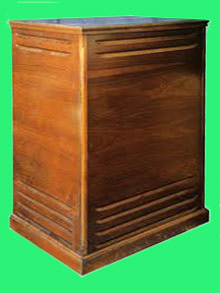LESLIE SPEAKERS
North Suburban HAMMOND ORGAN Service

Figure 1. A typical Leslie Speaker. There is no doubt that the Leslie sound is very distinctive, and when running at the normal or "tremolo" speed, the resulting effect is an infinitely complex combination of multiple vibratos and also amplitude-varying tremolo. The essential operating principles of the Leslie speaker are very simple; the Leslie speaker adds rotary motion to the sound sources (speakers) within the Leslie cabinet. Here's a photo of a typical Leslie speaker.
As with so many other items discussed on this website, there is a lot on the Internet about Leslie speakers.The usual models used with standard Hammond organs are the 122 and 122RV These have the balanced input which is designed to connect to the GG terminals in a typical Hammond B,C, or RT series instrument. The other two Leslies that can be used are the 147 and the 251, although these have an unbaanced input are would be more commonly used with the A100 series. The 251 is a two channel Leslie, where the secondary channel would carry the signal from the A100 reverb tank.
The unique effects of the Leslie result from Doppler pitch changes, directional loudness changes, and infinitely complex phase changing. Indeed the actions of a single Leslie in an average room as well as a large hall are so complicated that no two people hear exactly the same effect from the same Leslie, and yet the device itself is quite simple.
To understand the development of the Leslie, you need to realize that in a pipe organ, the tremolo/vibrato effect is created by a device which slightly alters the instantaneous pressure of the air supplied to the organ pipes, thereby making their instantaneous pitch and loudness both change. The pitch change, or vibrato, is the far more desirable effect as is evidenced by the immensely popular "sobbing tremolo" of the theater pipe organ's Tibia and Vox Humana pipe ranks.
The first commercially practical electronic organ was the Hammond, but as it states in our article on the typical Hammond organ, initially there was no practical way to produce a pitch-varying vibrato in a traditional Hammond tone wheel organ. Donald Leslie realized this grave shortcoming in the early Hammonds, and he also realized how poor the simple amplitude-varying tremolo in these instruments sounded, especially when compared against the big, lush vibrato in theater pipe organs. So he set about to overcome this, and after lots of experimentation, he developed the now famous Leslie speakers.
Although primarily intended for Hammonds, the "Leslie Sound" proved to be a big improvement for other makes of instruments besides Hammond. And by the 1950s. Hammond developed their now famous "scanner" vibrato, which is a very complex and good sounding electronic vibrato. Interestingly enough, while he was in control of the company, Laurens Hammond would not allow Leslie speakers to be used on the instruments he made, even though the sound was so popular that most Hammond dealers sold Leslie speakers in spite of Laurens Hammond's opposition and eventually Hammond gave their approval to the Leslie speaker and began to include self-contained versions of the Leslie in many of their newest models.
The Leslie effect is applied to the actual sound right as it leaves the speaker cones in the Leslie cabinets. Because of this, it can only be recorded with microphones, whereas the Hammond scanner vibrato is applied to the electrical signals within the console and therefore will work with any type of speaker that might be used on a Hammond. It can also be recorded directly without the need of a mic at all which makes for a very "clean" recording. The genuine Hammond Scanner vibrato is very good, and there are many who prefer the sound of the Hammond's own vibrato to that produced by a Leslie speaker, although from what informal anecdotal research I have done, I would say that the majority of Hammond players today prefer the Leslie effect. Interestingly, some very useful and wonderful-sounding effects result from the use of BOTH the Hammond scanner vibrato and the Leslie effect in combination, and a very sought-after package comprises a B3 or C3 Hammond with both a Hammond speaker, such as a PR40 along with a Leslie.